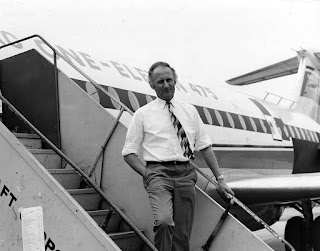Saturday, January 27, 2007
Friday, January 26, 2007
Jon Karkow 1962-2017

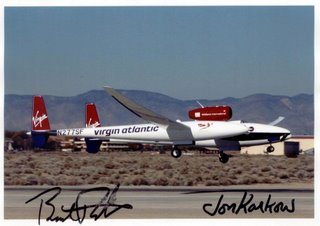
Thursday, January 25, 2007
John E.'Jack' Krings 1930-2014


Saturday, January 20, 2007
Arnold.G.Heimerdinger 1910-1975

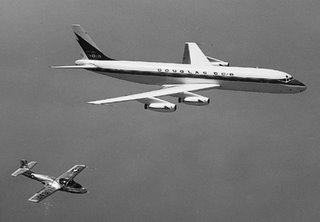 DC-8 MAIDEN FLIGHT
DC-8 MAIDEN FLIGHT Cover signed by A.G.Heimerdinger to celebrate the maiden fligt of Douglas DC-8 N8008D
Cover signed by A.G.Heimerdinger to celebrate the maiden fligt of Douglas DC-8 N8008DA.G. "Heimie" Heimerdinger, who commanded the maiden flight of the McDonnell Douglas DC-8 in 1958, joined Douglas in 1952 as project pilot for the DC-6B and successively flew the DC-7, DC-8 and DC-9, gaining several point-to-point records for the DC-8 series. He retired in 1974.
Tuesday, January 16, 2007
Craig Penrice 1959-
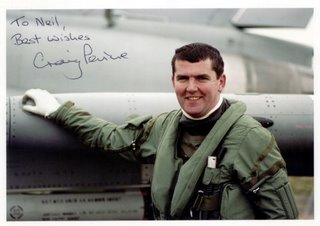
Craig Penrice spent 18 years in the Royal Air Force during which time he flew Lightnings, Hawks, and F-15s with the United States Air Force and trained as a test pilot with the United States Navy. He was the second RAF pilot to fly the Eurofighter Typhoon during his time at Boscombe Down. He joined BAE Systems in 1998 maintaining his connection with Typhoon and was the lead project pilot until June 2003, when a broken back during an ejection from a Hunter resulted in an end to his fast jet flying career. Craig is currently advising on export opportunities for the Eurofighter Typhoon.
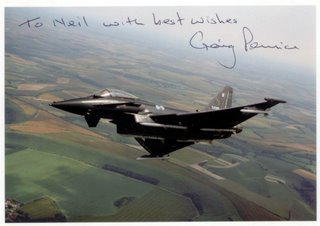
Friday, January 12, 2007
Lt Cdr Peter Melville "Sheepy" Lamb DSC*, AFC 1923-2000





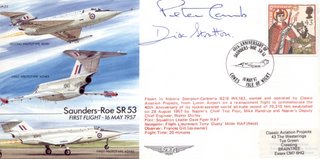
A Fleet Air Arm pilot who survived seven wartime prangs at sea to win a DSC and Bar in Korea and Suez. He was the third and last test pilot of the Saunders-Roe SR.53.
In 1941 he went to HMS St Vincent, Gosport, for initial training as a naval airman and then to America for flying instruction at Pensacola, returning as a Midshipman (A) RNVR at the end of 1942. His flying career began inauspiciously when he was delivering a Seafire to Christchurch, Hampshire, in June 1943. He joined 808 squadron, flying Seafires from the escort carrier Battler, to give fighter cover over the Salerno landings in September.
In 1944, Lamb joined 807, flying Seafires from another escort carrier, Hunter, taking part in the landings in the south of France in August and carrying out anti-shipping strikes in the Aegean later in the year.He joined Hunter in 1945 to join the East Indies Fleet in the Indian Ocean, where 807 gave air support to the reoccupation of Rangoon in May and anti-shipping strikes in June. After the war, Lamb applied for a regular RN commission and was appointed an instructor at the School of Naval Air Warfare, HMS Vulture, St Merryn.
Postwar Lamb spent a year at the Empire Test Pilots School and went to Boscombe Down for three years, during which he tested more than 20 different types of aircraft. On becoming Chief test pilot for Saunders Roe, Lamb flew the rocket jet aircraft SR53, designed to be manned at instant readiness on a carrier's catapult, thus cutting the cost of maintaining combat air patrols over the fleet. The first prototype SR53 crashed on take-off at Boscombe Down, killing the pilot John Booth, but Lamb successfully flew the second, achieving British records for height, of 56,000 feet, and speed, of Mach 1.45, before the whole project was cancelled.
When Saunders Roe was absorbed into the Westland Group, Lamb converted to helicopters. He also became involved with Sir Christopher Cockerell's prototype SRN 1 hovercraft, and made the first hovercraft crossing of the Channel on July 25 1959, the 50th anniversary of Bleriot's historic flight.
Lt Col (ret) Robert L.Riedenauer 1936-2007


Lieutenant Colonel Robert L. Riedenauer is the only test pilot to have flown the U-2, the SR-71 Blackbird and the F-117 Stealth Fighter, highlighting a military and civilian flight test career that included advanced development of some of the most famous aircraft of the 20th Century. He earned a Bachelor of Science Degree in Mechanical Engineering from Arizona State University in 1967 and graduated from the USAF Test Pilot School at Edwards Air Force Base in 1969.
Riedenauer conducted performance and handling quality tests of the FB-111A, prototype development of the Pre-SCANA F-111 and various programs in the U-2. Reidenauer then flew developmental flight tests of the SR-71 at Air Force Plant 42 in Palmdale and later retired from the Air Force as Chief of SR-71 Flight Test. At Lockheed Skunk Works, he was an Engineering Test Pilot and later Director of Operations. He helped design, develop and test classified programs and served as one of Lockheed's principal test pilots during the initial flight tests of the F-117A Stealth Fighter. Riedenauer flew the first production flight of the F-117 and later retired from Lockheed in 1993.
Riedenauer is a Fellow in the Society of Experimental Test Pilots and has logged over 6,500 hours in more than 50 different aircraft, including the T-33, A/T-37, T-38, F-86, F-104, F-105, F-4, F/FB-111, F-117, SR-71, B-52 and U-2. He also flew 120 combat missions in the F-105 in Southeast Asia in 1968 and was honored with the Air Force Distinguished Flying Cross with two oak leaf clusters, the Air Medal with eleven oak leaf clusters and the Meritorious Service Medal.
Wednesday, January 10, 2007
Wg Cdr J.A. 'Robby' Robinson 1932-
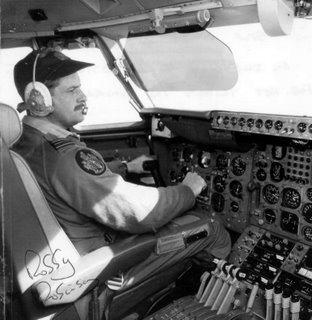
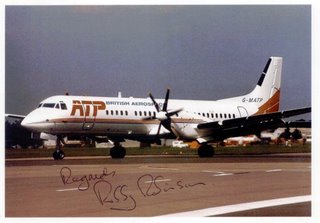

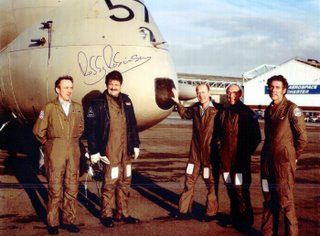
Robby Robinson was born in Gloucester in 1932. He was educated at Sir Thomas Rich's School in the city and joined the RAF at Royal Air Force College Cranwell in 1950. He graduated from there in 1952 and then trained on Meteors and Canberras, joining 10 Squadron at RAF Scampton in September 1953, flying Canberras.
He transferred to the V Force in 1956 as a co-pilot on 90 Squadron flying Vickers Valiants, becoming a Captain in 1959. He volunteered and passed for the Empire Test Pilot School in 1961 and joined number 21 Course in January 1962. After graduation he was posted to B Squadron A&AEE Boscombe Down in 1963, testing Victors, Vulcans, Canberras and many other aircraft, before being transferred to E Squadron in 1964 as the Senior Pilot, testing, among other transport aircraft, the Belfast, Argosy, Beverley, HS125 and Basset.
In 1966 he was awarded the Queen's Commendation for Valuable Services in the Air. After Staff College and a year in the Intelligence Branch he returned to ETPS as a Tutor from 1968 to 1970, being awarded the Air Force Cross for his time there. On promotion to Wing Commander he suffered three years on the ground in the Ministry of Defence before returning to Boscombe Down, firstly as the Deputy Superintendent of Flying and then, in 1976, the Chief Instructor and Head of ETPS.
In 1978 he was recruited by Hawker Siddeley to become a Test Pilot at Woodford, becoming the deputy Chief Test Pilot in 1979. He took over as Chief Test Pilot from Sir Charles Masefield in 1981, overseeing the testing of the Nimrod MR2, the Nimrod AEW, the BAe 748 and the ATP, the maiden flight of which he carried out at 10.00am August the 6th 1986; this time and date being announced two years before. For this the Guild of Air Pilots and Navigators awarded him the Derry and Richards medal.
He retired at age 55 and joined Air Bridge at East Midlands, flying the Merchantman freighter, until retiring again in 1991 to teach on the ATP and BAe 146 simulators at Woodford. He became the Director of Flight Test and Chief Test Pilot at the International Test Pilot School at Woodford in 1998, retiring from there in 1999 when the school moved to Coventry, whereupon he returned to teaching on the BAe 146 simulator. He finally retired in 2001 to write and lecture after nearly fifty years of flying.
He has flown over 80 powered aircraft types from supersonic fighters to helicopters as well as several types of gliders.
Sunday, January 07, 2007
James D. Eastham 1918-2016






James D. Eastham tested the world’s first three Mach 3+ jet aircraft: the A-12, YF-12A, and SR-71. He entered Civilian Pilot Training in 1942. Following World War II, he served in Europe for four years and was one of the original Berlin Airlift pilots. He was also a fighter pilot during the Korean War. In 1956 Eastham joined Hughes Aircraft Company as Project Engineering Test Pilot for the Falcon Missile project, flying 800 missions and firing 350 missiles, a record for any one person. He was Hughes’ B-58 Project Test pilot for the development of the ASG-18 radar system and AIM47A missile. In 1962 he joined the Lockheed California Company A-12 and YF-12A Blackbird program. On August 7, 1963, he was the first man to fly the YF-12A. Later, he moved to Edwards Air Force Base and was the second man to fly the SR-71. He flew the YF-12A through speed courses to perfect the techniques for setting the official world records in 1965. He logged 10,000 hours
Thursday, January 04, 2007
Anthony 'Tony' L. Blackman OBE 1928-2024




Tony Blackman was educated at Oundle School and Trinity College Cambridge, where he obtained an honours degree in Physics. After joining the Royal Air Force as a Maths and Physics Instructor, he learnt to fly, flew Vampires and Venoms in Germany.
Roy Radford 1928-2017
 Maiden flight of VC-10 Tanker conversion for RAF on 22nd June 1982 from Filton,flown by Roy Radford and John Lewis.
Maiden flight of VC-10 Tanker conversion for RAF on 22nd June 1982 from Filton,flown by Roy Radford and John Lewis. Concorde test flight from Filton,flown by Roy Radford.
Concorde test flight from Filton,flown by Roy Radford. BAC One-Eleven 475 flown by Roy Radford on demonstration tour to Bolivia. Aircraft is seen leaving Cochabamba.
BAC One-Eleven 475 flown by Roy Radford on demonstration tour to Bolivia. Aircraft is seen leaving Cochabamba.
Roy Radford, BAC Weybridge assistant chief test pilot, was on the maiden flight of the BAC 1-11 500 and was responsible for the entire One-Eleven 500 flight development programme.









